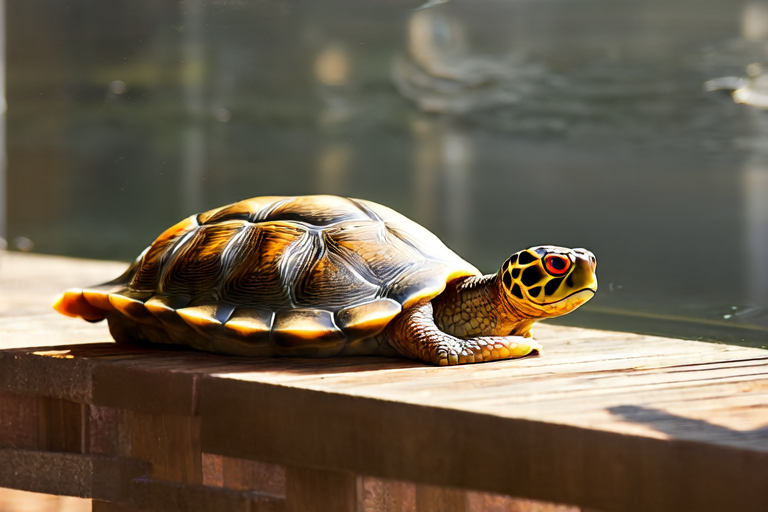Top 10 Secrets Every Red-Eared Slider Owner Should Know
The red-eared slider (Trachemys scripta elegans) is one of the most popular pet turtle species worldwide. Known for their striking appearance, these semi-aquatic turtles require specific care to thrive. This article will reveal ten secrets every red-eared slider owner should know, offering practical tips, essential care instructions, and insights into their behavior and health.
1. The Importance of Proper Habitat Setup
Creating an ideal habitat for your red-eared slider is crucial for its well-being. A well-designed tank or pond should have at least 10 gallons of water per inch of the turtle’s shell length. Ensure that the enclosure has both aquatic and basking areas. The water temperature should be maintained between 75°F and 80°F (24°C to 27°C), while the basking area should reach around 90°F (32°C). UVB lighting is essential for calcium absorption and vitamin D synthesis, promoting healthy bone growth.
2. Common Misconceptions About Their Lifespan
Many people believe that red-eared sliders live for only a few years. In reality, with proper care, they can live up to 40 years. However, neglecting their nutritional and environmental needs can significantly shorten their lifespan. Regular vet check-ups and maintaining optimal living conditions are key to ensuring your turtle lives a long and healthy life.
3. Dietary Needs and Feeding Habits
A balanced diet is vital for your turtle’s health. Young sliders are primarily carnivorous, feeding on insects, small fish, and worms. As they mature, their diet shifts towards more vegetation. Offer a variety of foods including commercial turtle pellets, leafy greens, and occasional treats like fruits or cooked vegetables. Avoid feeding them iceberg lettuce, as it lacks nutrients. Overfeeding can lead to obesity and other health issues, so monitor portion sizes carefully.
4. Essential Care Instructions for Longevity
Regular cleaning of the habitat is necessary to prevent bacterial growth and maintain water quality. Use a high-quality filtration system and perform partial water changes weekly. Clean the basking area daily to avoid mold and bacteria buildup. Additionally, provide fresh water daily and ensure that all equipment is functioning correctly. Regular vet visits are also important for early detection of any potential health problems.
5. Understanding Red-Eared Slider Behavior
Red-eared sliders are generally docile creatures but can exhibit territorial behaviors when space is limited. They tend to be solitary animals and may become stressed if housed with too many other turtles. Providing ample space and hiding spots can help reduce stress and promote natural behaviors. Interaction with humans should be gradual and gentle, allowing the turtle to acclimate to its environment before handling.
6. Health Issues to Watch Out For
Common health issues include respiratory infections, shell rot, and metabolic bone disease. Respiratory infections often manifest as wheezing, nasal discharge, or lethargy. Shell rot appears as soft spots on the carapace or plastron and requires immediate veterinary attention. Metabolic bone disease occurs due to calcium deficiency and presents with soft shells or swollen limbs. Preventive measures such as proper nutrition and UVB lighting can help mitigate these risks.
7. Myths About Their Lifespan and Longevity
One prevalent myth is that red-eared sliders grow to enormous sizes quickly. While they do grow rapidly during their first few years, their growth rate slows down after reaching maturity. Another misconception is that these turtles hibernate naturally in captivity. Unlike wild counterparts, captive sliders do not need to hibernate. Instead, they require consistent temperatures year-round.
8. Practical Tips for New Owners
For new owners, understanding the commitment involved in owning a red-eared slider is paramount. Research thoroughly before purchasing one, ensuring you’re prepared for the long-term responsibility. Consult with experienced owners or veterinarians who specialize in reptiles for guidance. Join online forums or local clubs to connect with others and gain valuable insights. Always purchase from reputable breeders or shelters rather than pet stores to support ethical practices.
9. Ensuring Your Turtle’s Happiness and Wellbeing
To ensure your turtle’s happiness, provide enrichment activities such as floating logs or toys. These stimulate mental engagement and mimic natural environments. Regular interaction with your turtle helps build trust and strengthens the bond between you. Patience is key when introducing new elements into their habitat; sudden changes might cause stress.
10. Advice for Experienced Owners
Experienced owners should continue learning about advancements in turtle care and stay updated on best practices. Participate in workshops or webinars offered by professional organizations. Share knowledge with newcomers through mentorship programs or community events. Encourage responsible ownership by advocating for stricter regulations regarding exotic pets and supporting conservation efforts.
In conclusion, owning a red-eared slider comes with significant responsibilities. By adhering to these top ten secrets, you can ensure your turtle leads a fulfilling life full of joy and health. Remember, each turtle is unique, requiring individualized attention and care. With dedication and love, you’ll enjoy many rewarding years together.
